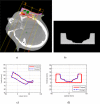Potential of 3D printing technologies for fabrication of electron bolus and proton compensators
- PMID: 26103473
- PMCID: PMC5690113
- DOI: 10.1120/jacmp.v16i3.4959
Potential of 3D printing technologies for fabrication of electron bolus and proton compensators
Abstract
In electron and proton radiotherapy, applications of patient-specific electron bolus or proton compensators during radiation treatments are often necessary to accommodate patient body surface irregularities, tissue inhomogeneity, and variations in PTV depths to achieve desired dose distributions. Emerging 3D printing technologies provide alternative fabrication methods for these bolus and compensators. This study investigated the potential of utilizing 3D printing technologies for the fabrication of the electron bolus and proton compensators. Two printing technologies, fused deposition modeling (FDM) and selective laser sintering (SLS), and two printing materials, PLA and polyamide, were investigated. Samples were printed and characterized with CT scan and under electron and proton beams. In addition, a software package was developed to convert electron bolus and proton compensator designs to printable Standard Tessellation Language file format. A phantom scalp electron bolus was printed with FDM technology with PLA material. The HU of the printed electron bolus was 106.5 ± 15.2. A prostate patient proton compensator was printed with SLS technology and polyamide material with -70.1 ± 8.1 HU. The profiles of the electron bolus and proton compensator were compared with the original designs. The average over all the CT slices of the largest Euclidean distance between the design and the fabricated bolus on each CT slice was found to be 0.84 ± 0.45 mm and for the compensator to be 0.40 ± 0.42 mm. It is recommended that the properties of specific 3D printed objects are understood before being applied to radiotherapy treatments.
Figures





Similar articles
-
A method for generating intensity-modulated radiation therapy fields for small animal irradiators utilizing 3D-printed compensator molds.Med Phys. 2020 Sep;47(9):4363-4371. doi: 10.1002/mp.14175. Epub 2020 Jul 6. Med Phys. 2020. PMID: 32281657
-
Efficient double-scattering proton therapy with a patient-specific bolus.Phys Med. 2018 Jun;50:1-6. doi: 10.1016/j.ejmp.2018.05.003. Epub 2018 May 26. Phys Med. 2018. PMID: 29891088 Free PMC article.
-
Improving 3D-printing of megavoltage X-rays radiotherapy bolus with surface-scanner.Radiat Oncol. 2018 Oct 19;13(1):203. doi: 10.1186/s13014-018-1148-1. Radiat Oncol. 2018. PMID: 30340612 Free PMC article.
-
Application of 3D printing for personalized boluses in radiotherapy: a systematic review.Rep Pract Oncol Radiother. 2025 Mar 21;30(1):100-113. doi: 10.5603/rpor.104014. eCollection 2025. Rep Pract Oncol Radiother. 2025. PMID: 40242418 Free PMC article. Review.
-
Application of Fused Deposition Modelling (FDM) Method of 3D Printing in Drug Delivery.Curr Pharm Des. 2017;23(3):433-439. doi: 10.2174/1381612822666161026162707. Curr Pharm Des. 2017. PMID: 27784251 Review.
Cited by
-
Clinical application of 3D-printed-step-bolus in post-total-mastectomy electron conformal therapy.Oncotarget. 2017 Apr 11;8(15):25660-25668. doi: 10.18632/oncotarget.12829. Oncotarget. 2017. PMID: 27784001 Free PMC article.
-
Feasibility of Customized Thermoplastic Patient-Specific Helmet Bolus for Scalp Irradiation Using Volumetric-Modulated Arc Therapy Planning.Technol Cancer Res Treat. 2024 Jan-Dec;23:15330338241241898. doi: 10.1177/15330338241241898. Technol Cancer Res Treat. 2024. PMID: 38557213 Free PMC article.
-
Development and validation of a 3D-printed bolus cap for total scalp irradiation.J Appl Clin Med Phys. 2019 Mar;20(3):89-96. doi: 10.1002/acm2.12552. Epub 2019 Mar 1. J Appl Clin Med Phys. 2019. PMID: 30821903 Free PMC article.
-
A Patient-Specific Polylactic Acid Bolus Made by a 3D Printer for Breast Cancer Radiation Therapy.PLoS One. 2016 Dec 8;11(12):e0168063. doi: 10.1371/journal.pone.0168063. eCollection 2016. PLoS One. 2016. PMID: 27930717 Free PMC article.
-
Technical note: A comparison of in-house 3D-printed and commercially available patient-specific skin collimators for use with electron beam therapy.J Appl Clin Med Phys. 2024 May;25(5):e14366. doi: 10.1002/acm2.14366. Epub 2024 Apr 26. J Appl Clin Med Phys. 2024. PMID: 38669190 Free PMC article.
References
-
- Low DA, Starkschall G, Sherman NE, Bujnowski SW, Ewton JR, Hogstrom KR. Computer‐aided design and fabrication of an electron bolus for treatment of the paraspinal muscles. Int J Radiat Oncol Biol Phys. 1995;33(5):1127–38. - PubMed
-
- Perkins GH, McNeese MD, Antolak JA, Buchholz TA, Strom EA, Hogstrom KR. A custom three‐dimensional electron bolus technique for optimization of postmastectomy irradiation. Int J Radiat Oncol Biol Phys. 2001;51(4):1142–51. - PubMed
-
- Kim MM, Kudchadker RJ, Kanke JE, Zhang S, Perkins GH. Bolus electron conformal therapy for the treatment of recurrent inflammatory breast cancer: a case report. Med Dosim. 2012;37(2):208–13. - PubMed
Publication types
MeSH terms
Substances
LinkOut - more resources
Full Text Sources
Other Literature Sources

